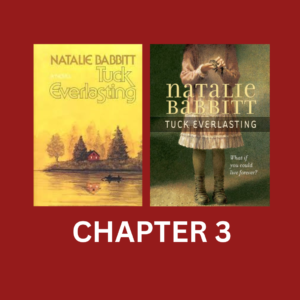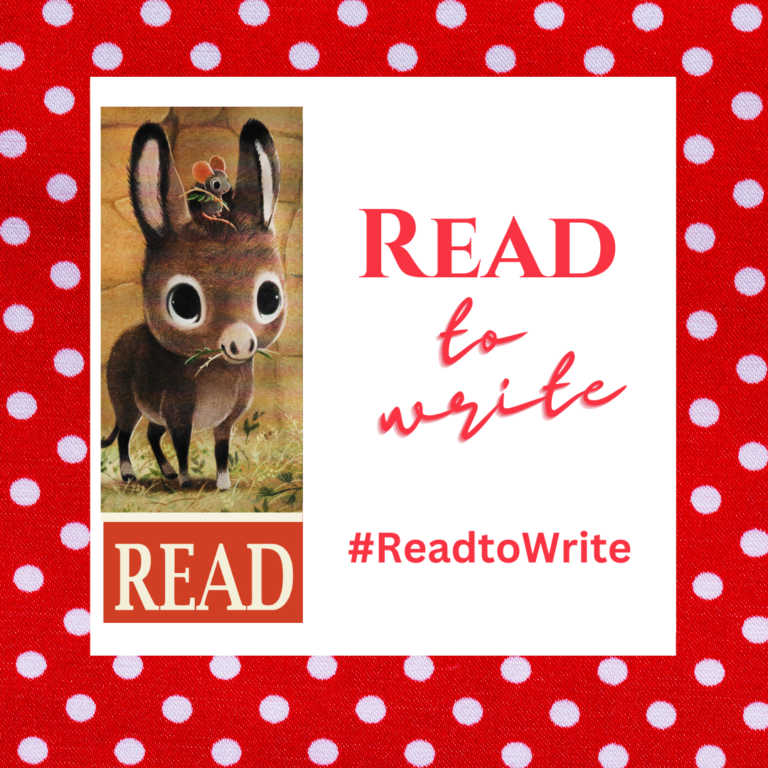
 .
.
In Chapter 3 of Tuck Ever lasting, Natalie Babbitt teaches potential writers a lesson about “Showing” and not “Telling,” as we meet Winifred Foster. Babbitt doesn’t “Tell” us much about WInifred in this chapter. Rather, we are able to glean an unerstanding of who she is [or“See” her] by overhearing her conversation with a toad and through her reactions to the controling voices of her mother and her grandmother.

“At noon of that same day in the first week of August, Winnie Foster sat on the bristly grass just inside the fence and said to the large toad who was squatting a few yards away across the road, ‘I will, though. [run away] You’ll see. Maybe even first thing tomorrow, while everyone’s still asleep’ It was hard to know whether the toad was listening or not. Certainly, Winnie had given it good reason to ignore her. She had come out to the fence, very cross, very near the boiling point on a day that was itself near to boiling, and had noticed the toad at once….
“‘Look here, toad,’ she said, thrusting her arms through the bars of the fence and plucking at the weeds on the other side. ‘I don’t think I can stand it much longer.’ At this moment a window at the front of the cottage was flung open and a thin voice—her grandmother’s—piped, ‘Winifred! Don’t sit on that dirty grass. You’ll stain your boots and stockings’ And another, firmer voice—her mother’s—added, ‘Come in now, Winnie. Right away. You’ll get heat stroke out there on a day like this. And your lunch is ready.’ … Babbitt, Tuck, pgs 13-14.
To understand who Winnie is, the fence is significant. As we hear her grandmother’s and mother instructions for Winnie, we begin to unerstand why she feels that she is caged.
Notice that Babbitt provides a character study the Toad in this chapter, When Winifred tells the Toad her story, he reacts in a notable way. At the begnning of their encounter, WInifred had been tossing pebbles toward the Toad, and they had barely missed him;
“…since every pebble missed its final mark, the toad continued to squat and grimace without so much as a twitch. Possibly it felt resentful. Or perhaps it was only asleep. In either case, it gave her not a glance when at last she ran out of pebbles and sat down to tell it her troubles.” Babbitt, Tuck, pgs. 13-14.
After telling the frog that she wanted to run away, the following exchange took place:
” She leaned her forehead against the bars and after a short silence went on in a thoughtful tone. ‘I’m not exactly sure what I’d do, you know, but something interesting—something that’s all mine. Something that would make some kind of difference in the world. It’d be nice to have a new name, to start with, one that’s not all worn out from being called so much. And I might even decide to have a pet. Maybe a big old toad, like you, that I could keep in a nice cage with lots of grass, and . . .’ At this the toad stirred and blinked. It gave a heave of muscles and plopped its heavy mudball of a body a few inches farther away from her.” Babbitt, Tuck, pgs, 14-15.
During this conversation with theToad, Winnie herself was trapped inside the cage-like fence of her front yard. In her final comments to the frog, the reader learns how Winnie felt about her cage:
“‘It’d be better if I could be like you, out in the open and making up my own mind. Do you know they’ve hardly ever let me out of this yard all by myself? I’ll never be able to do anything important if I stay in here like this. I expect I’d better run away.’ She paused and peered anxiously at the toad to see how it would receive this staggering idea, but it showed no signs of interest. ‘You think I wouldn’t dare, don’t you?’ she said accusingly. ‘I will, though. You’ll see. Maybe even first thing in the morning, while everyone’s still asleep.'” Babbitt, Tuck, pg. 15.
What Does It Mean to Show and Not Tell in Writing?
- Create a more engaging and memorable reading experience: by actively involving the reader in the story.
- Add drama and tension: by allowing readers to witness the events unfold rather than simply being told about them.
- Develop characters more effectively: by revealing their thoughts and emotions through their actions and expressions.
- Create a richer and more immersive setting: by using sensory details to bring the world of the story to life.
- Telling: “The monster was terrifying.”
- Showing: “The towering creature loomed over her, its eyes glowing with an unnatural light. Its claws scraped against the ground, and a low growl rumbled from its throat.”
- Telling: “He was angry.”
- Showing: “His fists clenched at his sides, and his jaw tightened. His eyes narrowed, and a vein throbbed on his forehead.”

Many of us write, but few of us create literature. Natalie Babbitt’s Tuck Everlasting is literature. She had created literature before Chapter 1 of the book, Within a few words, Babbitt wrote volumes–in the Prologue. Within a few words, Tuck Everlasting had become more than a mere spattering of words. Natalie Babbitt said the following about words:
“You really have to love words if you’re going to be a writer, because as a writer, you certainly spend a lot of time with words.” ― Natalie Babbitt, Tuck Everlasting
Beyond a love of words, however, a good writer must learn to USE those words so that they can become more than a string of letters of the alphabet. I agree with Babbitt that the best way to learn to USE words is by reading great literature:
“What is your suggestion for someone who wants to start writing? Be a reader. It’s the only real way to learn how to tell a story.”
― Natalie Babbitt, Tuck Everlasting

In Chapter 3 of Tuck Everlasting, Babbitt has manipulated her words so that she has “SHOWN” us a great deal about who Winifred Foster is and why. Only from what you read in Chapter 3, write a description of Winifred Foster. In other words, “TELL” us who she is and why.
This is in reverse to most professionals consider to be the better way to write.
Look at how Winnie responds to her envornment and the toad and write an overview of what kind of person WInnie seems to be.
My Example of Showing and Not Telling You About the Zinnias in My Garden:
Discover more from Jacki Kellum
Subscribe to get the latest posts sent to your email.